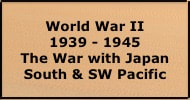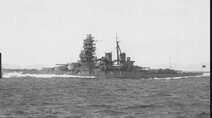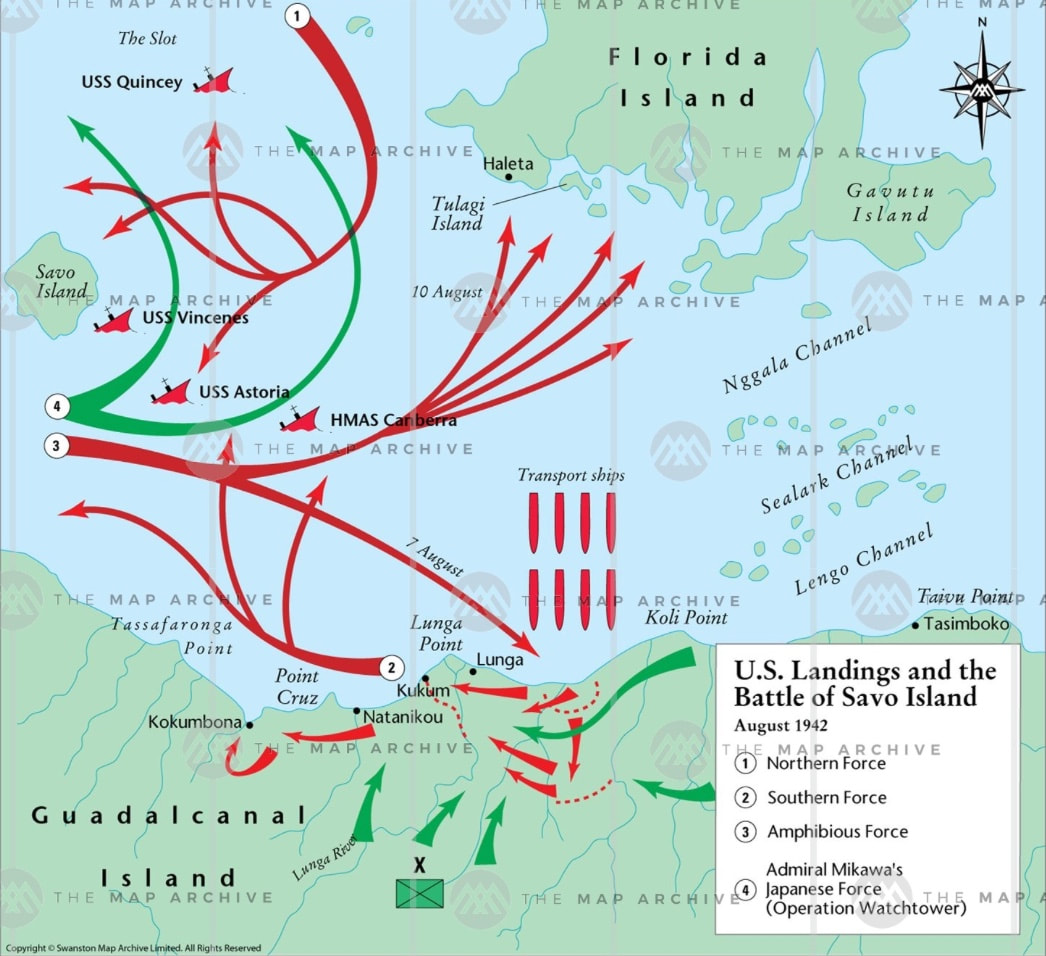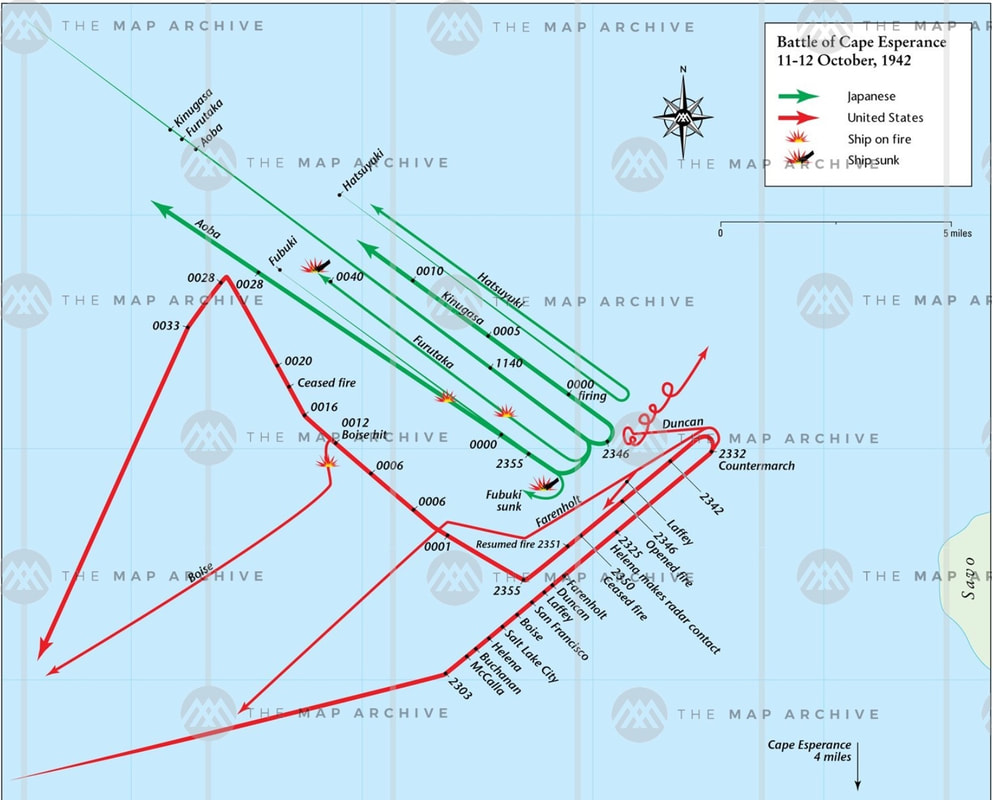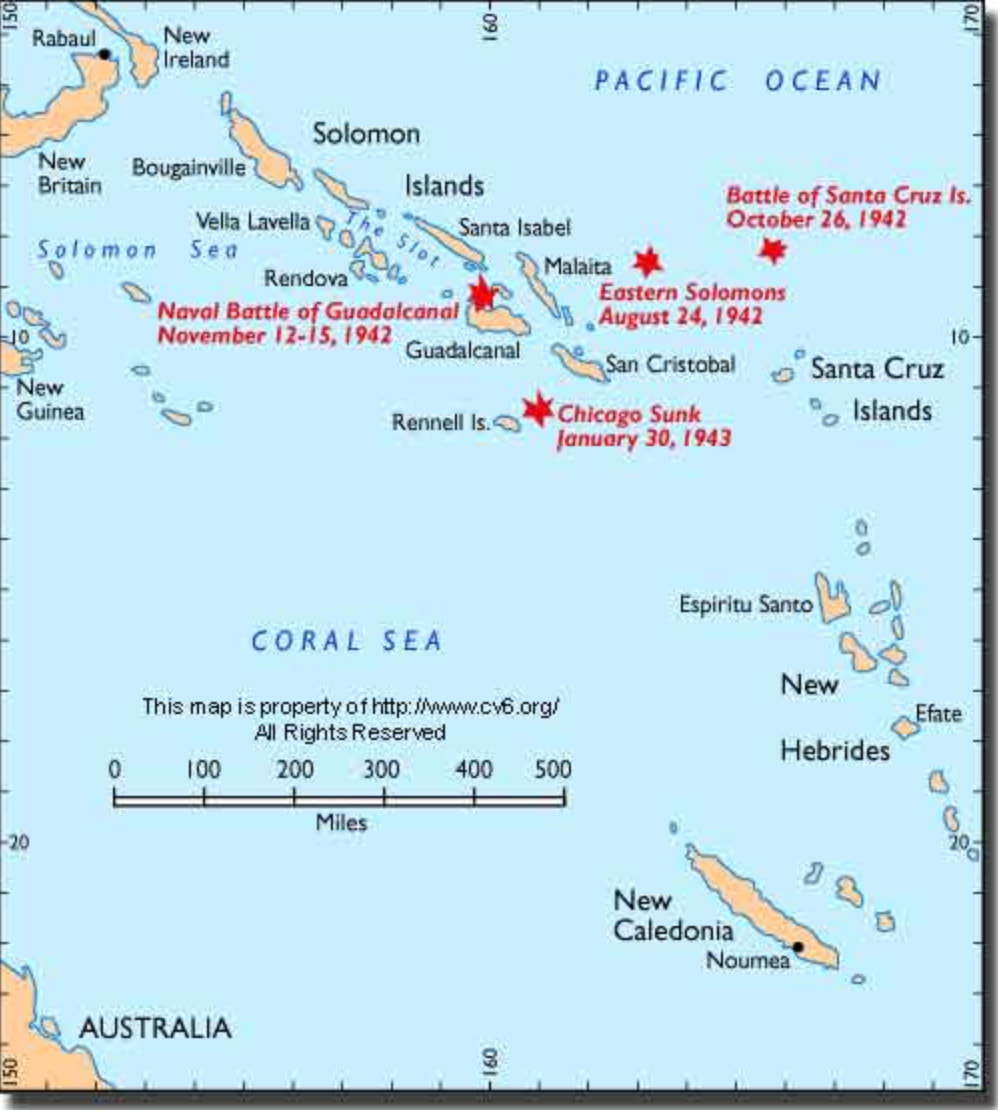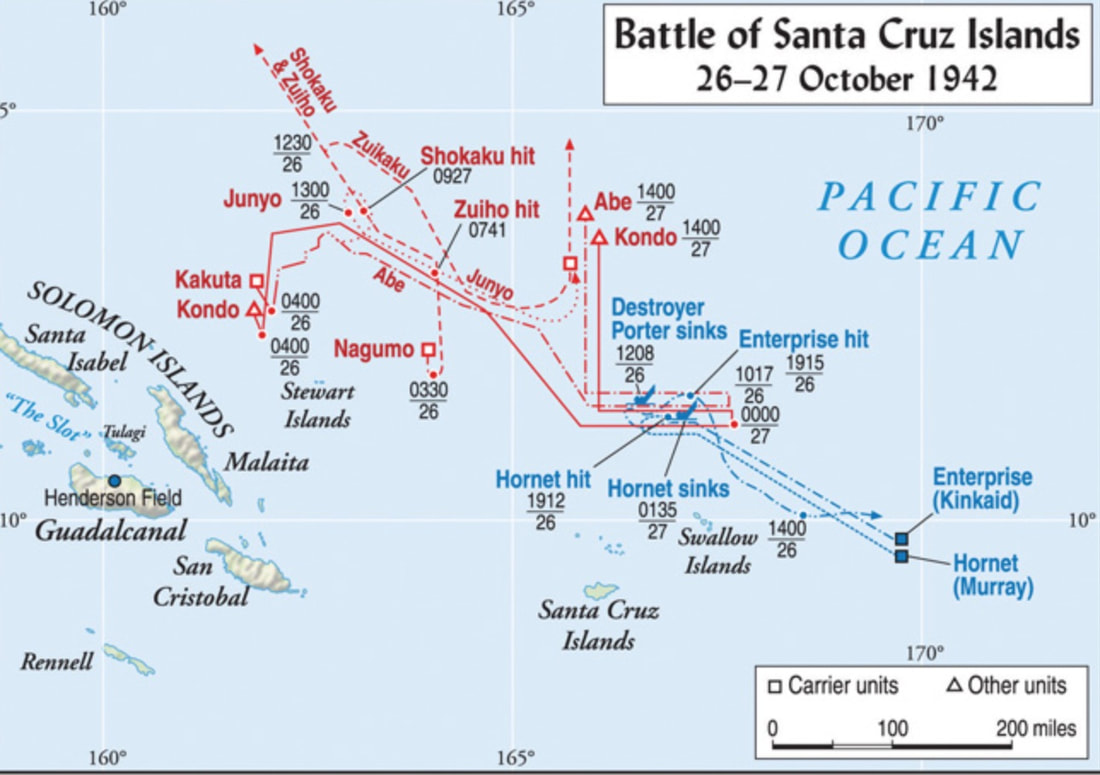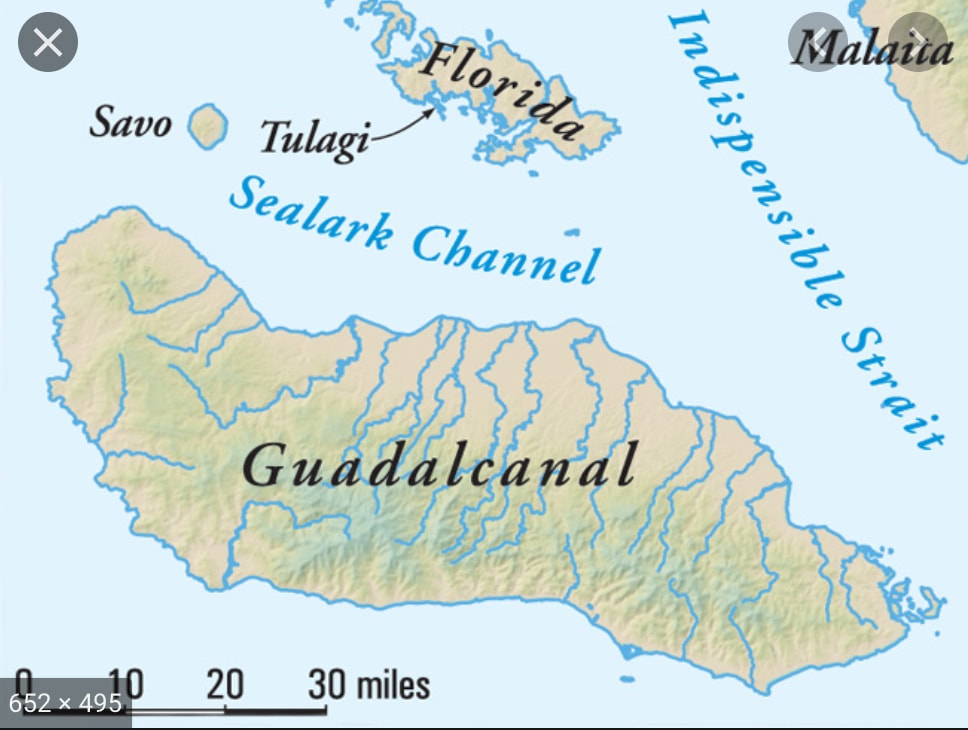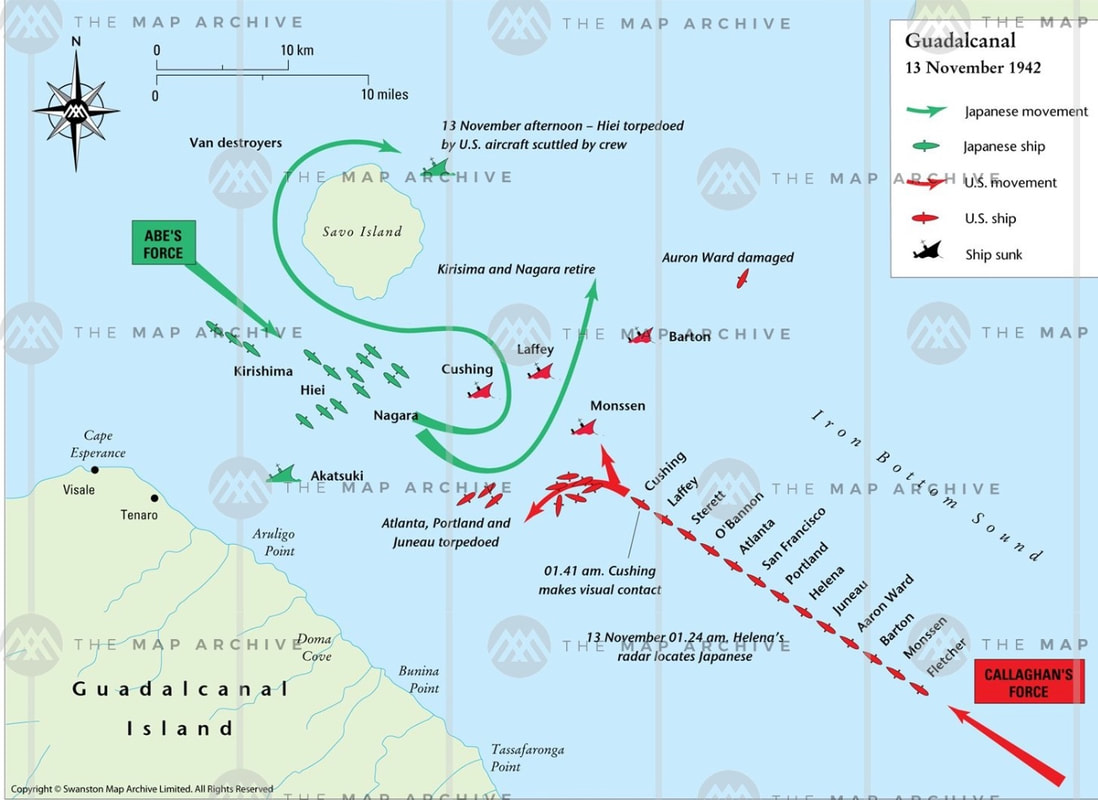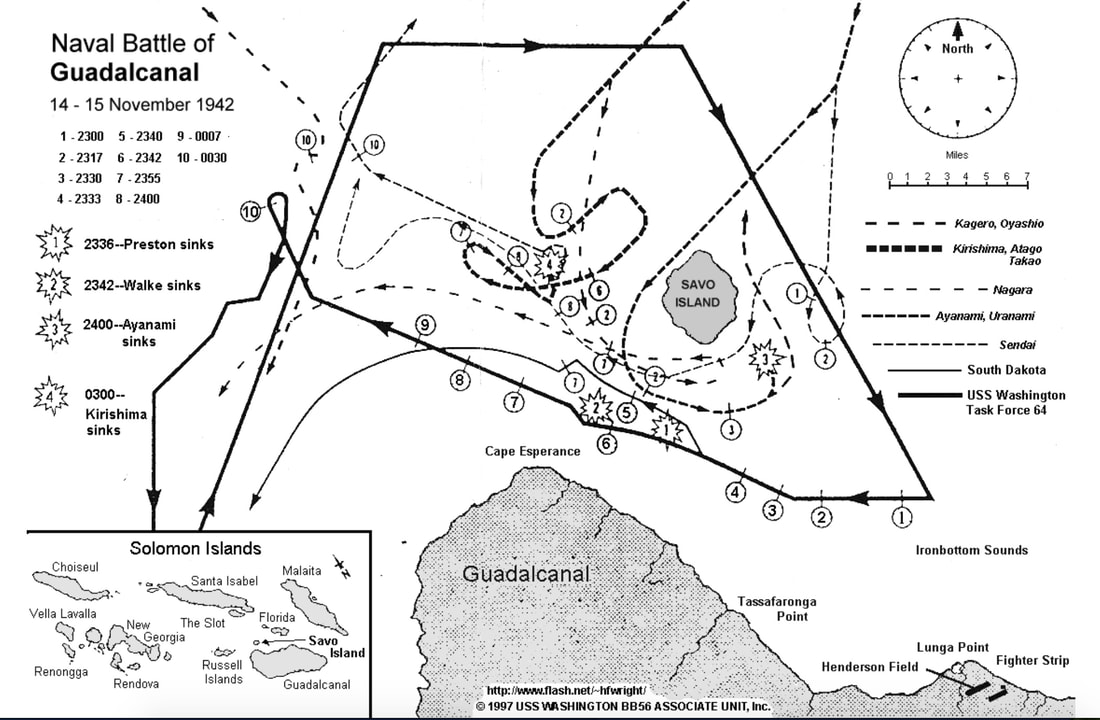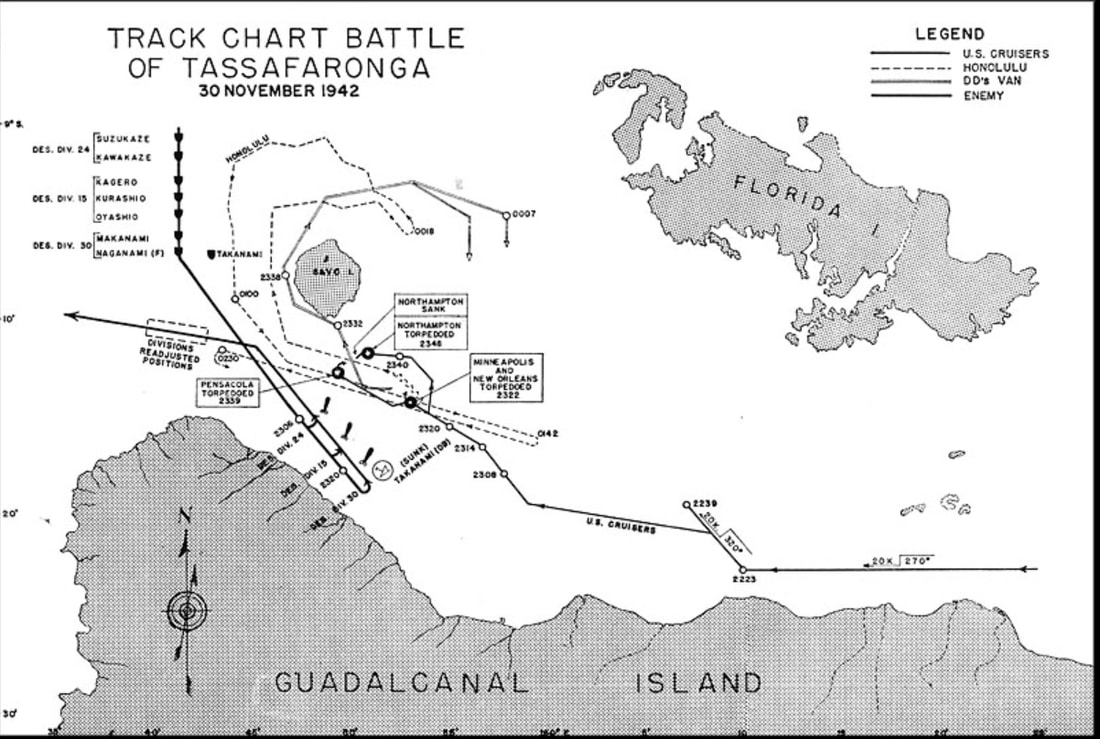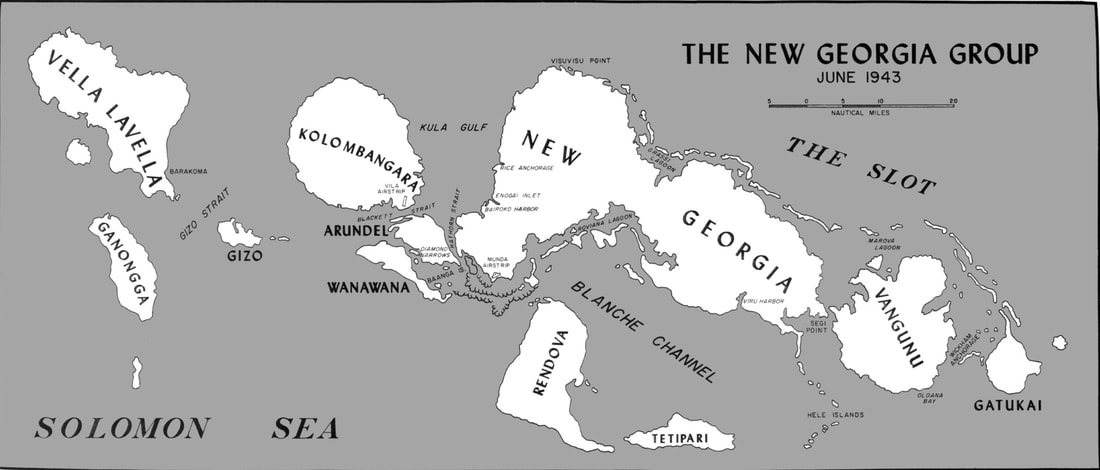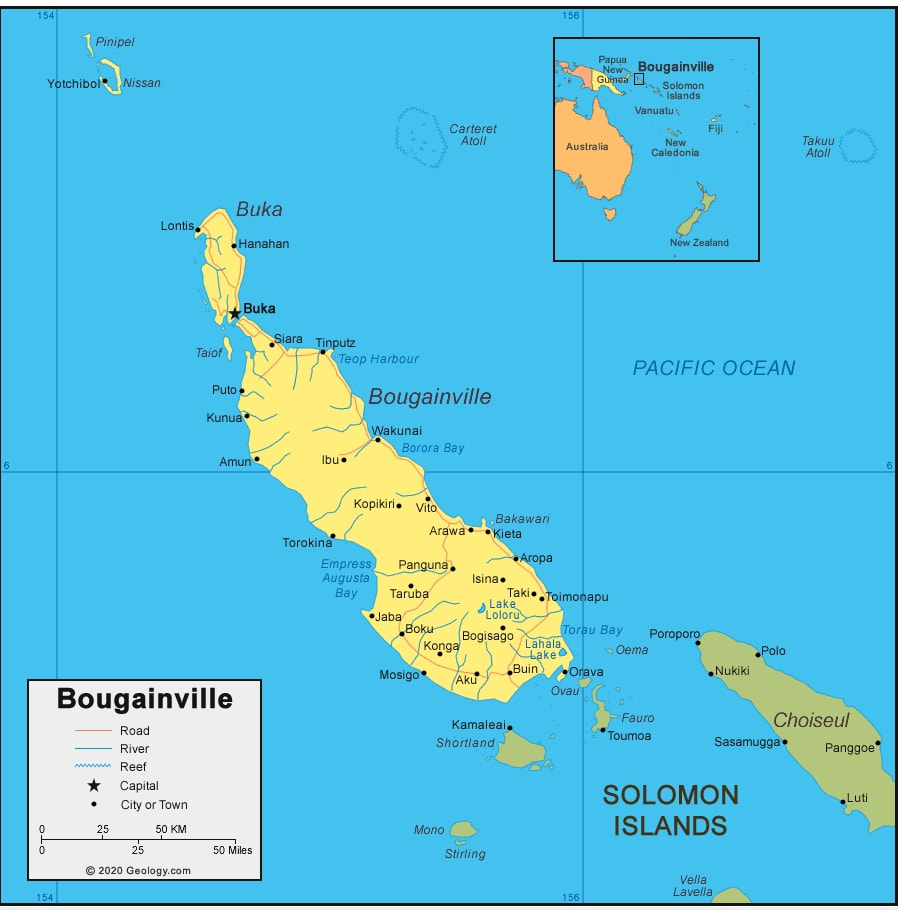bigpigeon.us webpage WWII Japan > South & SW Pacific > Naval War, Guadalcanal, © 2024 by Robert A. Christiansen, updated by RAC 25 Mar 2024.
In these numerous sea battles in the South Pacific in 1942 and 1943, the United States Navy was supporting amphibious landings and subsequent land offensives in the Solomon Islands.
In these numerous sea battles in the South Pacific in 1942 and 1943, the United States Navy was supporting amphibious landings and subsequent land offensives in the Solomon Islands.
The Securing Australia webpages:
- Securing Australia
- The Solomon Islands, Guadalcanal, August 1942–February 1943
- The Solomons Naval War, Guadalcanal
- Southeast New Guinea, Papua, July 1942–January 1943
I view WWII conflict in the Solomon Islands as consisting of three stages:
In the long run, the United States and Imperial Japanese navies suffered large and approximately equal losses as a result of the desperately-fought South Pacific area battles outlined below. However, in earlier battles the Japanese navy generally prevailed, partly because of lack of US training in naval night fighting techniques and superior Japanese torpedoes.
In the Southwest Pacific Area off New Guinea during the same period, the only naval action of note was the March 1943 Battle of the Bismarck Sea, in which US losses were minimal.
Only in the Battle of Leyte Gulf in October 1944 and in the Okinawa Campaign in mid 1945 would the US Navy suffer losses of the magnitude as experienced in the Solomon Islands.
In some of these actions, the US was joined by Australian or New Zealand forces.
- The Guadalcanal Island area, August 1942 - February 1943.
- The New Georgia Island area, mid 1943.
- The Bougainville Island area, beginning in October 1943. Unlike earlier Solomon Islands operations, Japanese forces remained on Bougainville Island until WWII ended.
In the long run, the United States and Imperial Japanese navies suffered large and approximately equal losses as a result of the desperately-fought South Pacific area battles outlined below. However, in earlier battles the Japanese navy generally prevailed, partly because of lack of US training in naval night fighting techniques and superior Japanese torpedoes.
In the Southwest Pacific Area off New Guinea during the same period, the only naval action of note was the March 1943 Battle of the Bismarck Sea, in which US losses were minimal.
Only in the Battle of Leyte Gulf in October 1944 and in the Okinawa Campaign in mid 1945 would the US Navy suffer losses of the magnitude as experienced in the Solomon Islands.
In some of these actions, the US was joined by Australian or New Zealand forces.
Part 1 - The Guadalcanal Island Area
The Early Solomon Islands Surface Battles
|
We begin with two night battles fought between surface ships off of Guadalcanal near Savo Island.
† Battle of Savo Island, before dawn on 9 Aug 1942
Battle of Cape Esperance, 11-12 Oct 1942
|
The Solomon Islands Carrier Battles
|
We now turn to two naval battles fought solely by naval aviation in the Pacific Ocean east of Guadalcanal as shown on the accompanying map.
Battle of the Eastern Solomons, 24-25 Aug 1942:
|
|
Battle of the Santa Cruz Islands, 26-27 Oct 1942
The Japanese task force's intent was to damage the US fleet to the extent that it could no longer protect the land and air operations on Guadalcanal. The aircraft carrier Hornet was lost from repeated Japanese torpedo plane attacks; the destroyer USS Porter was lost. Two Japanese carriers were badly damaged. |
Interdiction of US Supply Lines
Bases in the Noumea area in New Caledonia north of New Zealand and further north in the New Hebrides provided support for land, sea and air operations in the Guadalcanal area. Supplies and personnel needed to be transported by great distances over water -- Guadalcanal was 900 miles north of New Caledonia. Japanese forces did their best to disrupt resupply and reinforcement.
The attack of Submarine I-19, 15 September 1942:
A Task Force 18 convoy carrying the 7th Marine Regiment to Guadalcanal was attacked southeast of Guadalcanal. With one spread of six torpedoes, the Imperial Japanese Navy submarine I-19:
† The attack on the destroyer Meredith (DD-434) and tug Vireo (AM-52), 15 October 1942:
The Battle of Rennell Island, 29-30 January 1943:
The attack of Submarine I-19, 15 September 1942:
A Task Force 18 convoy carrying the 7th Marine Regiment to Guadalcanal was attacked southeast of Guadalcanal. With one spread of six torpedoes, the Imperial Japanese Navy submarine I-19:
- crippled the aircraft carrier Wasp (CV-7), which was scuttled later that day.
- damaged to destroyer O'Brien (DD-415), which sank from structural damage on 19 October en route to the US for repairs.
- damaged the battleship North Carolina (BB-55).
† The attack on the destroyer Meredith (DD-434) and tug Vireo (AM-52), 15 October 1942:
- Six US Navy ships, each towing a barge loaded with gasoline and bombs, left Espirtu Santo in the New Hebrides bound for Guadalcanal. They were discovered by Japanese Japanese aircraft on 15 October. All but the Meredith and Vireo turned back. After later word that Japanese warships were in the area, the Meredith took on the crew of the slow Vireo, intending a quick retreat. Unfortunately Japanese aircraft soon arrived and sank the Meredith, leaving the Vireo undamaged. Most personnel died; some survivors took refuge on the Vireo, which was later retrieved and restored to service.
The Battle of Rennell Island, 29-30 January 1943:
- Cruiser Chicago (CA-29), part of Task Force 18 escorting a troop convoy to Guadalcanal, sunk by aerial torpedoes south of Guadalcanal.
Naval Battles of Guadalcanal, 13-15 Nov 1942
|
These were the climatic naval battles in the Solomons. In mid-November, Japan attempted a major reinforcement and resupply of their army on Guadalcanal. This was to be coupled with a crippling sea bombardment of Henderson Field. The US had advance warning of Japanese plans.
What ensued were two brief and brutal nighttime surface engagements between US and Japanese naval forces near Savo Island. During these engagements, the majority of US ships involved were sunk or damaged. However, Japan also suffered heavy losses, including two battleships, failed in its goals, and never again sent a large fleet into the Solomons. Thus the US won a strategic victory. |
|
††††††† First Naval Battle of Guadalcanal:
The US naval force, Task Group 67.4, was commanded by Admiral Daniel Callaghan on the heavy cruiser USS San Francisco. This group had been protecting a convoy resupplying US forces on Guadalcanal.
|
High point of this battle:
|
|
Second Naval Battle of Guadalcanal:
Anxious to prevent the remaining Japanese fleet from bombarding Guadalcanal, the US Navy improvised a group of two battleships and four destroyers which had been protecting aircraft carriers in the area and thus not been engaged the previous night. This fleet, commanded by Admiral Ching Lee on the Washington, steamed west through Ironbottom Sound, again engaging Japanese forces near Savo Island. Of the four destroyers in the van, Walke and Preston were soon sunk, while the Benham and Gwin were disabled. The battleship South Dakota suffered a series of electrical failures and contributed little to the battle except for diverting Japanese attention from the Washington. The Washington engaged and sank the battleship Ayanami and a destroyer. |
Last Naval Battles of the Guadalcanal Campaign
|
†† Battle of Tassafaronga, 30 Nov 1942
In this night battle southeast of Savo Island, a United States cruiser-destroyer force attacked a force of Japanese destroyers delivering supplies to Guadalcanal. Japanese destroyers, using their superior torpedoes, sank one cruiser, the Northampton, and badly damaged three, the Minneapolis, New Orleans, and Pensacola. The US sank one destroyer by gunfire. This battle was a decisive Japanese victory. Moreover, one year into WW II, the US Navy had not yet dealt with its defective torpedoes. |
|
Battle of Rennell Island, 29-30 January 1943
This battle, near Rennell Island. south of Guadalcanal, consisted of extended Japanese air torpedo attacks on a large US naval force bringing replacements to Guadalcanal. The cruiser Chicago (CA-29) was damaged on the 29th and sunk on the 30th. US forces suffered 85 dead. |
Part 2 - Naval Battles Associated with the New Georgia Campaign, March - October 1943
Battle of Blackett Strait, 6 March 1943:
- Off south end of Kula Gulf, between New Georgia & Kolombangara.
- US force planning to shell Vila on Kolombangara encountered Japanese force bring supplies to Vila.
- no US dead.
- two Japanese destroyers sunk.
- This was a Japanese land-based air counteroffensive, launched against Allied installations in New Guinea and the Guadalcanal area.
- On 7 April, air attacks in the Guadalcanal area sank the destroyer USS Aaron Ward (DD-483) in Ironbound Sound and the oiler USS Kanawha (AO-1) in Tulagi anchorage.
- On 18 April, while traveling to the I-Go awards ceremony, Admiral Yamamoto, the planner of the Pearl Harbor attack, died when his aircraft was shot down by US Army Air Force aircraft.
- Three Japanese destroyers were damaged by mines on 8 May. One sank, the other two were finished off by US aircraft.
- off east coast of Kolombangara.
- USS Helena (CL-50) sunk; 168 US dead.
- one Japanese cruiser sunk.
- off NE coast of Kolombangara.
- USS Gwin (DD-433) scuttled, three light cruisers damaged; 89 US dead.
- one Japanese cruiser sunk.
- off west coast of Kolombangara.
- 15 PT-Boats from Rendova fire 30 torpedoes at Japanese destroyers returning from supply mission to Vila.
- John Kennedy's PT-109 cut in two by destroyer Amagiri; two dead.
- no Japanese damage or casualties.
- east of Vella Lavella.
- no US dead.
- three Japanese destroyers sunk.
- north of Vella Lavella.
- USS Chevalier (DD-451) sunk, USS Selfridge (DD-357) & USS O'Bannon (DD-450) badly damaged; 103 US dead.
- one Japanese destroyer sunk.
Part 3 - Naval Battles Associated with the Bougainville Campaign, November 1943
|
The Third Marine Division landed on the west coast of Bougainville on 1 November 1943, just north of Cape Torokina at the north end of Empress Augusta Bay.
Three naval battles pursuant to the landing are noted below. All three were US victories, incurred without major US losses. |
† Treasury Islands Invasion, 27 October 1943:
- The Treasury Islands, Mono and Stirling, appear on the bottom of the previous map.
- The Treasury Islands were seized by New Zealand and US forces for use during the pending Bougainville invasion.
- Japanese air attacks late on the 27th damaged the USS Cony (DD-508).
- Fought before dawn west of Cape Torokina, Bougainville.
- Japanese forces from Rabaul attempted to attack the Bougainville landing.
- 19 US dead.
- one Japanese cruiser and one Japanese destroyer sunk.
- 97 aircraft from carriers Saratoga and Princeton.
- Disabled four of the seven Japanese heavy cruisers from the rear Japanese base at Truk that were preparing for a larger attack on US Bougainville forces.
- Land-based US aircraft from New Guinea staged multiple attacks on Rabaul during this period.
- Fought at night off Cape St, George on the southern tip of New Ireland Is.
- US destroyer force attacked Japanese destroyers transferring personnel between Rabaul and Buka Is. just north of Bougainville.
- No US losses.
- Three Japanese destroyers sunk.
Sources for Big Pigeon's South & SW Pacific > Solomons Naval War webpage:
Pottawattamie Area WWII Dead - South & SW Pacific > Solomons Naval War:
† Beckendorf, Orville Leroy, SN 316-41-64, US Navy, Pott. Co.
- The webpage header photo, Imperial Japanese Navy Battleship Hiei, is courtesy of clickorlando.com. The Hiei was the first Japanese battleship sunk in WW II, on 14 Nov 1942 during the Naval Battle(s) of Guadalcanal.
- https://www.google.com/maps/d/viewer?ie=UTF8&t=h&oe=UTF8&msa=0&mid=1O-ln4_TfaVp76jRzZxwDgcfgqXU&ll=25.103266747572718%2C143.31372999999996&z=2, an interactive map showing 131 Pacific area military operations.
- The US Guadalcanal Landings, Sea Battle of Savo Island, and Battle of Cape Esperance maps - C/O The Map Archive.
- The Solomons Carrier Battles map - C/O http://ahoy.tk-jk.net/macslog/NavalBattlesintheSolomon.html.
- The Battle of Santa Cruz Islands map
- The Guadalcanal Area Physical Map is courtesy of the Warfare History Network.
- The Naval Battle of Guadalcanal -13 Nov map is courtesy of The Map Archive.
- The Naval Battle of Guadalcanal - 14-15 Nov map is courtesy of usswashington.com.
- The Battle of Tassafaronga map is courtesy of wikipedia.org.
- The New Georgia Island Group map was found at https://www.ibiblio.org/hyperwar/USMC/II/maps/USMC-II-II.jpg.
- The Bougainville Area map is courtesy of geology.com.
Pottawattamie Area WWII Dead - South & SW Pacific > Solomons Naval War:
- Taken from the bigpigeon.us WWII Dead module.
† Beckendorf, Orville Leroy, SN 316-41-64, US Navy, Pott. Co.
- Destroyer USS Laffey (DD-459); KIA 13 Nov 1942 in Ironbottom Sound, N of Guadalcanal, Solomon Is.; Laffey hit by 14” shell from Japanese battleship Hiei & torpedo, then exploded & sank; 59 dead, 186 survivors; First Naval Battle of Guadalcanal - South & SW Pacific > Solomons Naval War; BNR.
- USS Atlanta (CL-51); KIA 13 Nov 1942 Ironbottom Sound N of Guadalcanal; ship scuttled after extensive damage during nighttime action from a Japanese torpedo, Japanese gunfire and friendly fire from the USS San Francisco; 172 crew members plus an unknown number of Admiral Scott's staff died; First Naval Battle of Guadalcanal - South & SW Pacific > Solomons Naval War; BNR.
- Attack Transport USS McCawley (APA-4); KIA 30 Jun 1943 off Rendova, Solomon Is.; McCawley disabled by Japanese aircraft torpedo and then abandoned, 15 dead; McCawley accidentally sunk that night by US PT boats; South & SW Pacific > Solomons Naval War; BNR.
- Destroyer USS Selfridge (DD-357); KIA 6 Oct 1943 off Vella Levella Is., Solomon Is.; Selfridge damaged by enemy torpedo; 49 dead; Battle of Vella Levella - South & SW Pacific > Solomons Naval War.
- b. 9 Sep 1918 Kimballton, Audubon Co. s/o Christian T. Christiansen & Emma Larsen; entered service 17 Sep 1940 from Kimballton; bur. Bethany Luth. Cem., Kimballton.
- Cruiser USS New Orleans (CA-32); KIA 1 Dec 1942 Ironbottom Sound, N of Guadalcanal, Solomon Is.; New Orleans torpedoed by Japanese destroyer & heavily damaged; Battle of Tassafaronga - South & SW Pacific > Solomons Naval War.
- Destroyer USS Barton (DD 599) ; KIA 13 Nov 1942 in Ironbottom Sound, N of Guadalcanal, Solomon Is.; Barton sunk by two Japanese Long Lance torpedoes; 164 died, 68 survived; First Naval Battle of Guadalcanal - South & SW Pacific > Solomons Naval War; BNR.
- Destroyer USS Cony (DD 508); KIA 27 Oct 1943, during US/New Zealand invasion of Treasury Is., S. of Bougainville, Solomon Is.; Cony damaged by Japanese air attack, eight dead; Treasury Is. Invasion - South & SW Pacific > Solomons Naval War.
- Destroyer USS De Haven (DD-469); KIA 1 Feb 1943 in Ironbottom Sound, E of Savo Is., Guadalcanal, Solomon Is.; De Haven sunk by Japanese bombs; 167 died, 146 survived; South & SW Pacific > Solomons Naval War; BNR.
- Heavy Cruiser USS San Francisco (CA-38); KIA 13 Nov 1942 Ironbottom Sound, N of Guadalcanal, Solomon Is.; San Francisco hit by multiple Japanese shells, ~100 died; First Naval Battle of Guadalcanal - South & SW Pacific > Solomons Naval War; BNR.
- 6th Naval Construction Bn. (Seabees), based near Henderson Field, Guadalcanal, Solomon Is.; KIA 16 Oct 1942 off Lunga Pt., Guadalcanal; a 17-man detail was unloading gasoline from the USS McFarland onto a pontoon barge when the McFarland was attacked by nine Japanese dive bombers; nine seabees died from a direct hit on the barge; the McFarland also suffered damage & casualties during the attack; South & SW Pacific > Solomons Naval War.
- Cruiser USS Minneapolis (CA-36); KIA 30 Nov 1942 in Ironbottom Sound off Guadalcanal, Solomon Is.; Minneapolis torpedoed by Japanese destroyer & heavily damaged; Battle of Tassafaronga - South & SW Pacific > Solomons Naval War.
- Cruiser USS Juneau (CL-52); KIA 13 Nov 1942 SE of Guadalcanal, Solomon Is.; Juneau torpedoed & sunk by Japanese submarine I-26; 687 dead including the five Sullivan brothers, ten survived; aftermath of First Naval Battle of Guadalcanal - South & SW Pacific > Solomons Naval War; BNR.
- Cruiser USS Astoria (CA-34), KIA 9 Aug 1942 in Ironbottom Sound off Savo Is., Guadalcanal, Solomon Is.; Astoria sunk in night action, 219 dead, ~ 680 survivors; Battle of Savo Island - South & SW Pacific > Solomons Naval War; BNR.
- Destroyer USS Chevalier (DD-451); KIA 6 Oct 1943 off Vella Lavella Is., central Solomon Is.; Chevalier torpedoed & abandoned & scuttled early the following day, 54 dead; Sea Battle of Vella Lavella - South & SW Pacific > Solomons Naval War; BNR.
- served on USS California (BB-44) during first enlistment & on USS Kanawha (AO-1) during second enlistment; KIA 7 Apr 1943 Tulagi anchorage, near Guadalcanal, Solomon Is.; Kanawha attacked by Japanese dive bombers and sank the following day; 19 dead; Operation I-Go - South & SW Pacific > Solomons Naval War; BNR.
- Fleet Tug USS Vireo (AM-52); KIA 15 Oct 1942 off San Cristobal, SE of Guadalcanal, Solomon Is.; Japanese air attack on Vireo and destroyer USS Meredith (DD-434); Vireo damaged and crew transferred to Meredith; Meredith sank; 237 crew from Meredith and Vireo died; the abandoned Vireo survived intact and was later retrieved; The Meredith and the Vireo - South & SW Pacific > Solomons Naval War; BNR.
- Destroyer USS Gwin (DD-433); KIA 13 Jul 1943 in Kula Gulf, N of New Georgia Is., Solomon Is.; Gwin hit by destroyer torpedo & scuttled, 61 dead, 214 survivors; Battle of Kolombangara - South & SW Pacific > Solomons Naval War; BNR.
- Light cruiser USS Helena (CL-50); KIA 6 Jul 1943 Kula Gulf between New Georgia & Kolombangara Is., Solomon Is.; Helena sunk by Japanese destroyer torpedoes, 168 dead; Battle of Kula Gulf - South & SW Pacific > Solomons Naval War; BNR.
- Destroyer USS Aaron Ward (DD 483); KIA 7 Apr 1943 in Ironbottom Sound near Tulagi, Solomon Is.; Aaron Ward sunk by Japanese bombs while escorting LST-449; 27 dead; Operation I-Go - South & SW Pacific > Solomons Naval War; BNR.
- Destroyer USS Laffey (DD-459); KIA 13 Nov 1942 in Ironbottom Sound, N of Guadalcanal, Solomon Is.; Laffey hit by 14” shell from Japanese battleship Hiei & torpedo, then exploded & sank; 59 dead, 186 survivors; First Naval Battle of Guadalcanal - South & SW Pacific > Solomons Naval War; BNR.
- Heavy Cruiser USS San Francisco (CA-38); KIA 13 Nov 1942 Ironbottom Sound, N of Guadalcanal, Solomon Is.; San Francisco hit by multiple Japanese shells, ~100 died; First Naval Battle of Guadalcanal - South & SW Pacific > Solomons Naval War; BNR.
